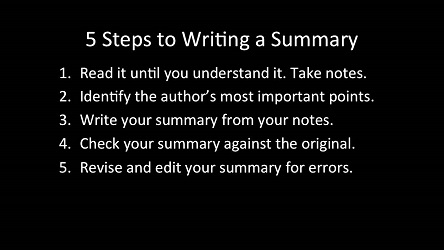SUMMARY WRITING कक्षा 12 अंग्रेज़ी
What is Summary Writing?
A summary is written in your own words. A summary contains only the ideas of the original text. Do not insert any of your own opinions, interpretations, deductions or comments into a summary.
किसी भी पैराग्राफ का सारांश (summary) आपके अपने शब्दों में लिखा जाता है। सारांश में केवल मूल पाठ के विचार होते हैं। सारांश में अपनी कोई राय, व्याख्या, टिप्पणी नहीं देनी चाहिए।
DOs of Summary Writing

DOs of Summary Writing
1) Read and re-read the passage.
1) गद्यांश को बार बार पढ़े।
2) Understand.
2) गद्यांश को पढ़ने के बाद उसे समझने की कोशिश करे।
3) Read the instructions.
3) निर्देश को ध्यान से पढ़िए।
4) Find exactly what you need to summarise.
4) ठीक वही चीज़ें या पंक्तियाँ खोजें जो आपको सारांशित करने की आवश्यकता है।
5) Identify the main idea through the process of asking questions.
5) प्रश्न पूछने की प्रक्रिया के माध्यम से मुख्य विचार की पहचान करें।
6) Form short sentences on your own.
6) सारांश लिखते समय छोटे वाक्यों का प्रयोग करे।
7) Connect the sentences using linkers.
7) वाक्यों को जुड़ने वाले शब्दों का उपयोग करें।
8) Remove redundant words and sentences from the key sentences.
8) मुख्य वाक्यों से अनावश्यक शब्दों और वाक्यों को हटा दें।
9) Omit details.
9) विवरण और अनावश्यक वाक्यों को छोड़ दें।
10) Avoid your own interpretation
10) अपनी खुद की व्याख्या न करे।
DON’Ts of Summary Writing

DON’Ts of Summary Writing
1) Don’t include details that are not mentioned in the text.
1) उन विवरणों को शामिल न करें जिनका उल्लेख पाठ में नहीं किया गया है।
2) Don’t add lines according to your viewpoint or interpretation.
2) अपने दृष्टिकोण या व्याख्या के अनुसार सारांश लिखते समय खुद से पंक्तियाँ न जोड़ें।
3) Don’t comment or give examples.
3) सारांश लिखते समय अपनी टिप्पणी या कोई उदाहरण न दे।
Steps for Summary Writing

Steps for Summary Writing
Step 1: Read the article twice.
Step 1: लेख को दो बार पढ़ें।
Step 2: Ask questions about the purpose of writing.
Step 2: लिखने के उद्देश्य के बारे में प्रश्न पूछें।
Step 3: Identify the main idea.
Step 3: मुख्य विचार की पहचान करें।
Step 4: Write the first draft.
Step 4: अपना पहला सारांश लिखने की कोशिश करे।
Step 5: Revise your first draft and edit it.
Step 5: अपने पहले सारांश को दुबारा पड़े और जहाँ गलतियाँ लगे उसे ठीक करे।
Step 6: Write the final draft.
Step 6: सब पढ़ने के बाद अपना अंतिम सारांश लिखे।
Example
Passage
A country’s standard of living generally depends on the size of its national income. Standards of living are measured by such things as the number of cars, televisions, telephones, computers, washing machines, and so on, for every one thousand people. There is, however, no standard international index, which is why national income figures are used as a substitute. But the use of these figures to compare the standard of living between countries needs to be done carefully, because they are, at best, only a rough guide which can be misleading. The main problem here is that it is necessary to have a common unit of measurement if any sort of comparison is to be made at all. It has become the custom to use the dollar, and each country’s currency is converted at its official exchange rate into a national income figure in dollars. Now, since the exchange rate is often set at an artificial level in relation to dollars, you are likely to end up with a figure that is useless for your purposes.
Summary
Due to the absence of the standard international index, national income figures are generally applied to measure and compare standards of living with dollars being the common unit, which may lead to the fact that the figures converted can be misleading and useless as the exchange rate of each country is artificially regulated.
Practice Exercise

Read and summarize the passages in your own words.
Passage 1
Virgin Media is the first telecoms and media company in the UK to offer “quad play” to its customers, bundling ultra-fast broadband, TV and fixed-line telephony alongside its existing mobile phone services. But with these expanding product lines comes increasing operational complexity. Historically, most of Virgin’s sales were made through calls to its contact centres, but as consumer preferences change, the company has recognised the need to move away from a culture that fostered competition between the different sales channels towards a unified approach.
Passage 2
Whilst enjoying a creamy pint of draft Guinness, have you ever wondered about its journey from brewery to bar the famous black stuff (it’s actually ruby red) is available in 100 countries worldwide and is brewed in almost 50. As you can imagine, it’s a complex undertaking getting it from plant to pub and one that’s fundamental to the company’s success. A Deloitte team from Risk Analytics. Financial Advisory and Consulting has spent the past two years working with Diageo on its commercial and supply chain programme, Project ice Cap. The objective was to iron out peaks and troughs in sales by improving the client’s understanding of customer demand and sales behaviour. At the same time, we looked at removing inefficiencies to help save costs. The programme spanned Diageo’s enormous logistics process from production and warehousing to distribution and retail. Our work supported Diageo in becoming a consumer-driven organization, and with reduced volatility and unpredictability in customer behaviour.
Passage 3
When an individual drives a car, heats a house, or uses an aerosol hairspray, greenhouse gases are produced. In economic terms, this creates a classic negative externality. Most of the cost (in this case, those arising from global warming) are borne by individuals other than the one making the decision about how many miles to drive or how much hairspray to use. Because the driver (or sprayer) enjoys all the benefits of the activities but suffers only part of the cost, that individual engages in more than the economically efficient amount of the activity. In this sense, the problem of greenhouse gases parallels the problem that occurs when someone smokes a cigarette in an enclosed space or litters the countryside with fast-food wrappers. If we are to get individuals to reduce production of greenhouse gases to the efficient rate, we must somehow induce them to act as though they bear all the costs of their actions. The two most widely accepted means of doing this are government regulation and taxation, both of which have been proposed to deal with greenhouse gases.
Passage 4
Communication is a part of our everyday life. We greet one another, smile or frown, depending on our moods. Animals, too, communicate, much to our surprise. Just like us, interaction among animals can be both verbal or non-verbal. Singing is one way in which animals can interact with one another. Male blackbirds often use their melodious songs to catch the attention of the females. These songs are usually rich in notes variation, encoding various kinds of messages. Songs are also used to warn and keep off other blackbirds from their territory, usually a place where they dwell and reproduce. Large mammals in the oceans sing too, according to adventurous sailors. Enormous whales groan and grunt while smaller dolphins and porpoises produce pings, whistles and clicks. These sounds are surprisingly received by other mates as far as several hundred kilometres away.
Passage 5
The system of Crop Intensification is a climate-smart, agro-ecological methodology for increasing the productivity of crops and more recently other crops by changing the management of plants, soil, water, and nutrients. SCI methodology is based on four main principles that interact with each other. Early, quick and healthy plant establishment; Reduced plant density; Improved soil conditions through enrichment with organic matter; Reduced and controlled water application. Based on these principles, farmers can adapt recommended SCI practices to respond to their agro-ecological and socio-economic conditions. Adaptations are often undertaken to accommodate changing weather patterns, soil conditions, labour availability, water control, access to organic inputs, and the decision whether to practice fully organic agriculture or not. In addition, the SCI principles have been applied to feed rice and to other crops, such as wheat, sugarcane, pulses, showing increased productivity over current conventional planting practices.
ANSWERS
Summary of Passage 1
Change in consumer preferences drove Virgin Media to diversify from existing conventional telecom services to a unified approach such as the ultra-fast broadband ‘quad play’ which, in turn, has increased operational complexities.
Summary of Passage 2
Having collaborated with Diageo, Deloitte has undertaken research on the manufacturing process of the world-famous Guinness brand, which not only comprises of effective understanding of clientele behaviour but is also instrumental in making Diageo a consumer-driven organization.
Summary of Passage 3
Whereas the fundamental essence of greenhouse gases emphasizes the significance of economic terms, the corresponding impacts of a classic negative externality such as costs of global warming and bearing by individuals are acknowledged, and reducing production of such gases could be inferred evidently from the efficient rate, which the potential implications of inducing individuals as well as the government regulation and taxation are presumed.
Summary of Passage 4
Whereas the fundamental essence of greenhouse gases emphasizes the significance of economic terms, the corresponding impacts of a classic negative externality such as costs of global warming and bearing by individuals are acknowledged, and reducing production of such gases could be inferred evidently from the efficient rate, which the potential implications of inducing individuals as well as the government regulation and taxation are presumed.
Summary of Passage 5
System of Crop Intensification practice, a contemporary agro-ecological technique to strengthen the betterment of the plantation of crops like wheat, rice, pulses and so forth, over the traditional process, works on four principles basically by ameliorating and adjusting the soil cum farming conditions to achieve high yield.